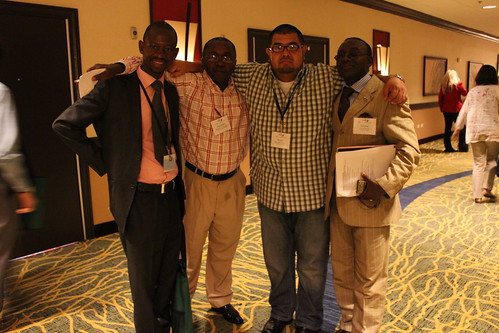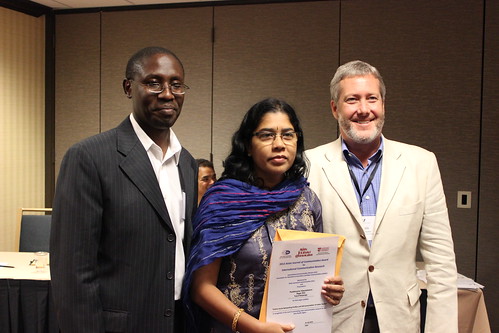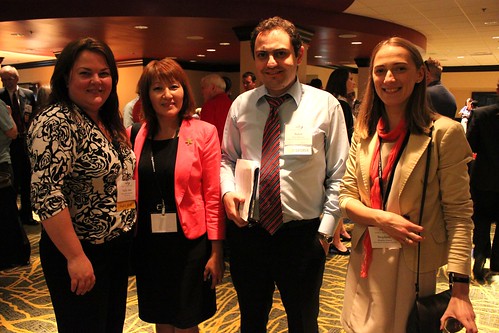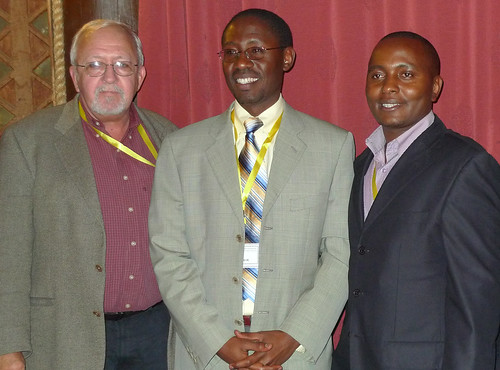By Lindsay Boyle
From August 9 through August 12, the 2012 SUSI scholars participated in the 2012 Association for Education in Journalism and Mass Communication Conference in Chicago.
The SUSI summer institute — in which scholars from all over the world come to the E.W. Scripps School of Journalism at Ohio University to study journalism and media — is funded by an annual renewable grant from the U.S. Department of State’s Study of the U.S. Branch in the Office of Academic Exchange Programs.
The AEJMC Conference is an annual event in which journalism scholars from throughout the United States and around the world engage in panels, presentations and other sessions related to research and teaching.
While in Chicago, the scholars were free to attend sessions of their choice, as well as other events such as a keynote ceremony and evening receptions. Many scholars also used some of their free time to go sightseeing in the city.
Scholar Dr. Aysha Abughazzi said that the conference well organized, but added that she sometimes had trouble choosing among the many simultaneous sessions.
“Other than that, I enjoyed attending sessions, getting to know new people in the field and sharing in the discussions,” she said.

Scholars Prof. Godfrey Danaan, Prof. Alexandre Twizeyumukiza, Prof. Hugo Zarate and Prof. Divine Bisong pose for a picture in between sessions at the AEJMC 2012 Conference.
During the afternoon of Friday, August 9, six SUSI scholars were part of a panel that was moderated by professor Mary Rogus, academic director of the OU SUSI program. The session was called “Arab Spring on TV: Global Perspectives on Coverage by CNN, BBC and Aljazeera.”
The six participating scholars were Abughazzi, from Jordan; Dr. Murad Abdullah, from Yemen; Dr. Alexsandr Kazakov, from Russia; Prof. Hugo Zarate, from The Bahamas; Dr. Ibaa Awad, from Sudan, and Prof. Taimoor Noori, from Afghanistan. They each spoke about various aspects of media coverage and public opinion of the Arab Spring as experienced in their countries.
“I was privileged to participate in such an international conference,” Abughazzi said. “It allowed me and my colleagues — who come from six different countries that are either directly or not directly involved in the events of the Arab Spring — to share with other scholars in the field our side of the story on a very hot and controversial topic.”
She explained that people of different countries watch different news stations to receive information about the Arab Spring based on how trustworthy they think the stations are and what kind of agenda they think the stations have. In Jordan, she said that Aljazeera is usually the public’s first choice, although some Jordanians also tune in to Western media outlets such as CNN and BBC.

SUSI scholar Dr. Murad Abdullah presents during the Arab Spring panel at the AEJMC 2012 Conference in Chicago, Ill.
Abughazzi said that the feedback she and her colleagues received about their panel was favorable.
“Many panel attendees continued the discussion on the various aspects of the topic — coverage of the Arab Spring — following the panel,” she said. “The questions we received indicated to us that people in the west were interested in learning our side of the story.”
On Thursday, August 8, SUSI Program Director Dr. Yusuf Kalyango was a panelist during a session called “African Media, the Arab Spring and Democratization: The ‘Unseen’ and ‘Unmentioned’ Social Side of the News Revolution.”
Specifically, Kalyango discussed media and democratization in Africa in relation to one overarching question: “Is an Arab Spring conceivable in Africa?”
Kalyango also coauthored a paper about social networking in India. The paper was presented in a refereed research paper session on Thursday, and also won the Asian Journal of Communication Award for International Communication Research. One of the other authors of that paper, Dr. Peddiboyina Vijaya Lakshmi, was a 2011 OU SUSI scholar.

The 2011 SUSI scholar Dr. Peddiboyina Vijaya Lakshmi and Dr. Yusuf Kalyango receive an International Communication Research Award sponsored by the Asian Journal of Communication Award.
In addition, SUSI program assistants Sally Ann Cruikshank, Ashley Furrow and Jim DeBrosse presented a total of eight papers at the AEJMC Conference.
Papers authored or co-authored by Furrow discussed topics such as the mission of Champion magazine, an influential female sportswriter named Mary Garber, and fans’ perceptions of local and national media coverage of college sports scandals.
Cruikshank’s papers examined issues such as media coverage of the genocides in southern Sudan and in Rwanda, as well as media coverage of France’s burqa ban.
One of DeBrosse’s papers offered strategies for reporters to challenge customer access barriers at shopping malls, while his other paper examined the censorship of Wikimedia versus that of mainstream media.
Collectively, OU graduate students had a total of 19 papers accepted into the 2012 AEJMC Conference.
Cruikshank said the benefits of attending AEJMC will last long after the conference is over for scholars.
“It’s a chance to connect with other scholars who share similar research and teaching interests,” she said. “In fact, two scholars from last year’s SUSI program at Scripps enjoyed the conference so much, they came back again this year. It was great to see them there."

Program assistant Sally Ann Cruikshank poses with SUSI scholars Prof. Karlyga Myssayeva, Prof. Suren Deheryan and Prof. Bogdana Nosova at the AEJMC Opening Reception.
Sunday, August 26, 2012
SUSI scholars attend AEJMC Conference in Chicago
Topics: AEJMC, IIJ, International Journalism, SUSI
Thursday, August 23, 2012
Final Thoughts: London OLympics
Covering the London Olympics
After three and a half weeks of living out a dream, my time in England is coming to an end. However, I still have a lot to write about. I want to try and sum up the last, and busiest, week of the trip. So sit back and relax, I’m about to cover a lot of ground in a small space.
Hopping on the Gymnastics Bandwagon
Covering the London Olympics
Guys, I’m going to let you in on a little secret.
Wednesday, August 22, 2012
IIJ, African Studies Program anticipate "Year for African Journalism"
By Lindsay Boyle
In recent years, the E.W. Scripps School of Journalism's Institute for International Journalism and the African Studies Program at Ohio University have gradually expanded their collaboration with each other. To showcase that expansion, the two groups have decided to hold a “Year for African Journalism” during the 2012-13 school year.
The abstract program aims to capitalize on a noticeable increase in student interest in Africa by teaching students more about African journalism. It will do so primarily by bringing two prominent African media scholars to the OU campus — one during Fall Semester and one during Spring Semester. Additional events and conferences will be held as well.
One major part of the Year for African Journalism is that Ernest Waititu will be the Glidden Visiting Professor during Fall Semester. Waititu is an OU alumnus who participated in the graduate programs of both the E.W. Scripps School of Journalism and the African Studies Program from 2003 to 2006, obtaining master’s degrees in both. He is currently the program director of health and digital media at Internews in Nairobi.
Internews is a U.S. government-supported NGO that provides training for journalists throughout Africa and has a goal of promoting freedom of expression. In addition to his work with that organization, Waititu founded an online news digest called Afrikanews, and has contributed to various publications in Kenya.
When he was a student at OU, he covered international news for the Athens News and was able to obtain an internship at CNN. Recently, Waititu hosted a workshop for East African journalists at his Internews offices. The workshop focused on health issues, taught techniques in digital journalism and archival research, and encouraged discussion about ethics and other contemporary issues.
As the Glidden Visiting Professor at OU, Waititu will teach the Foreign Correspondence course, and will assist with International Media Systems course lectures. He will also deliver a public lecture about his work at Internews.

Dr. Steve Howard and Dr. Yusuf Kalyango pose with Ernest Waititu.
Waititu will have many additional responsibilities. He will offer students advice about international opportunities. He will assist members of the African Studies Program and the E.W. Scripps School of Journalism’s Institute for International Journalism with creating and launching the Scripps College of Communication’s New African Media for Social Change conference. Finally, Waititu will help plan the annual IIJ study abroad program, which will ideally take place in Ghana during the 2013-14 school year.
For Spring Semester, Kojo Yankah has agreed to come to OU for the African Studies Program’s West African Research Association Residency. Yankah, who has established himself as a prominent and award-winning media figure in West Africa, has also been a minister in the government of Ghana, and is the founder and president of the African University College of Communication (AUCC). Additionally, Yankah has established his own marketing communications consultancy, Yankah and Associates, is currently a fellow of the Institute of Public Relations, Ghana, and has spent time as its president in the past.
Collaboration between AUCC and OU has increased in recent years with the hope of educating more OU students in communications-related majors about Africa. In the past, OU President Roderick McDavis has given a commencement speech at AUCC, and senior E.W. Scripps School of Journalism faculty member Dr. Ralph Izard has taught classes there. Additionally, the two universities signed a Memorandum of Understanding when Yankah visited the OU campus in August of 2011.
During his month-long residency, Yankah will host a public lecture series about African media issues, which will be streamed on multiple university-related websites. He will also speak to Scripps College of Communication student organizations, sit for interviews with student journalists, speak with local media about African economic and political progress, and be interviewed for the West African Research Association Bulletin.
The Glidden Visiting Professor is hosted by the African Studies Program and by the IIJ. Those organizations will combine to pay for event hospitality and incidentals for Waititu. The West African Research Association residency is sponsored by the African Studies Program, which provides housing for Yankah during his residency.
The IIJ strives to prepare students to work as international journalists and to increase overall international communication. The African Studies Program at OU is one of 10 National Resource Centers for African Studies in the U.S.
Tuesday, August 21, 2012
The day a stranger in London confirmed my future
Covering the London Olympics
London's Biggest Secret: USA Women's basketball 39 game winning streak
Covering the London Olympics

Maya Moore, University of Conneticut legend, answers reporters questions about team chemistry.

Coach Geno directs Maya Moore, #7, on how to run the play. This is the team’s last practice before facing Australia.
The people you meet along the way
Covering the London Olympics

Megan Hickok and Colin Brown sight see London on the Big Bus Tour.

A group of Scripps students pose with local police after chatting about their unique helmets and duties during the Olympic games.

Megan Hickok and Danny Medlock pose with the official 2012 Olympic mascot.


